The Sales Playbook is composed of Events displayed in the Event List, in Gantt and in Kanban.
You can access Playbook in different ways based on your configuration. See the general accessibility description here.
Note: A ClosePlan must be created in order to see the Playbook. If you have not created a ClosePlan, follow our description here.
Events are the key components of a ClosePlan and represent the tasks required to complete a deal in your organization.
Events are displayed in the Event List, in the Gantt view and in the Kanban view.
Events are set by templates, but you can also create new events
Events can be set with or without Stage progression, Dependencies and/or Checklist items.
Sales stages monitor the progression of the deal. If event stages are set with auto-progression, they will affect event behavior and the subsequent closure of each stage.
Additional settings that may affect event closure and dependent stage closures are: Event Dependencies and Checklist items.
Stage Closure: there are 3 conditions that can affect the closing of an event:
Block if event is required: Events can be set as required, and will block users from moving to the next stage until the event is completed.
Auto-Complete open Event: Events are created without being Required. You can move to the next stage even if there is an open event.
Block if event is required, otherwise Auto-Complete Event: This is a combination of both possibilities. If there is a required event, you will be blocked from moving to the next stage, otherwise you can move to the next stage even if there is an open event that is not required.
Event Closure: there are 2 conditions that can affect the closing of an event
1.Event Dependency
2. Checklist item - Lists the tasks of team members.
Example:
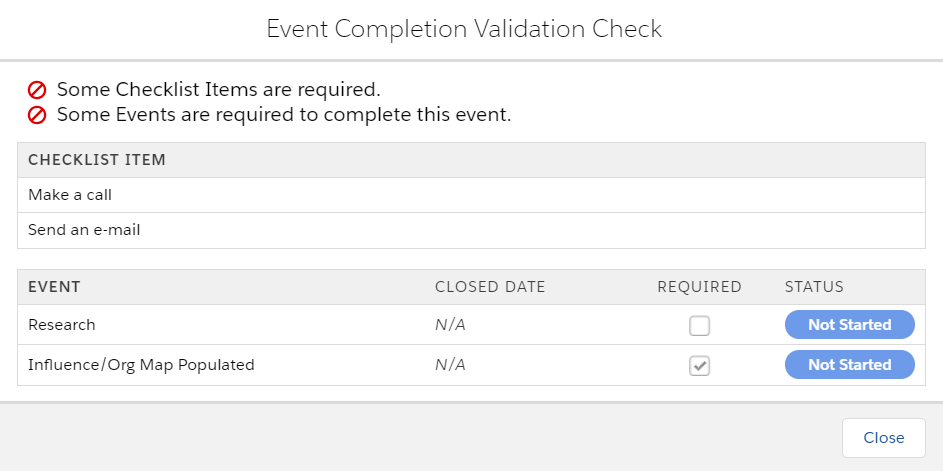
You can add a new Events to customize your process.
Creating a new event does not permit you to set a Dependency on another Event, and you cannot mark new tasks in the checklist as mandatory.
Note: These options are only possible when creating a new template for a given ClosePlan from the ClosePlan admin section.
New Events can be created from:
When creating a new Event, the Detail section of the event allows you to add Checklist items and attach Files for that Event.
After the Event is created, editing or viewing the Event allows you to add Notes and Chatter.
The event panel window can be displayed in 2 ways: You can view all data stacked on one page, or in individual tabs.
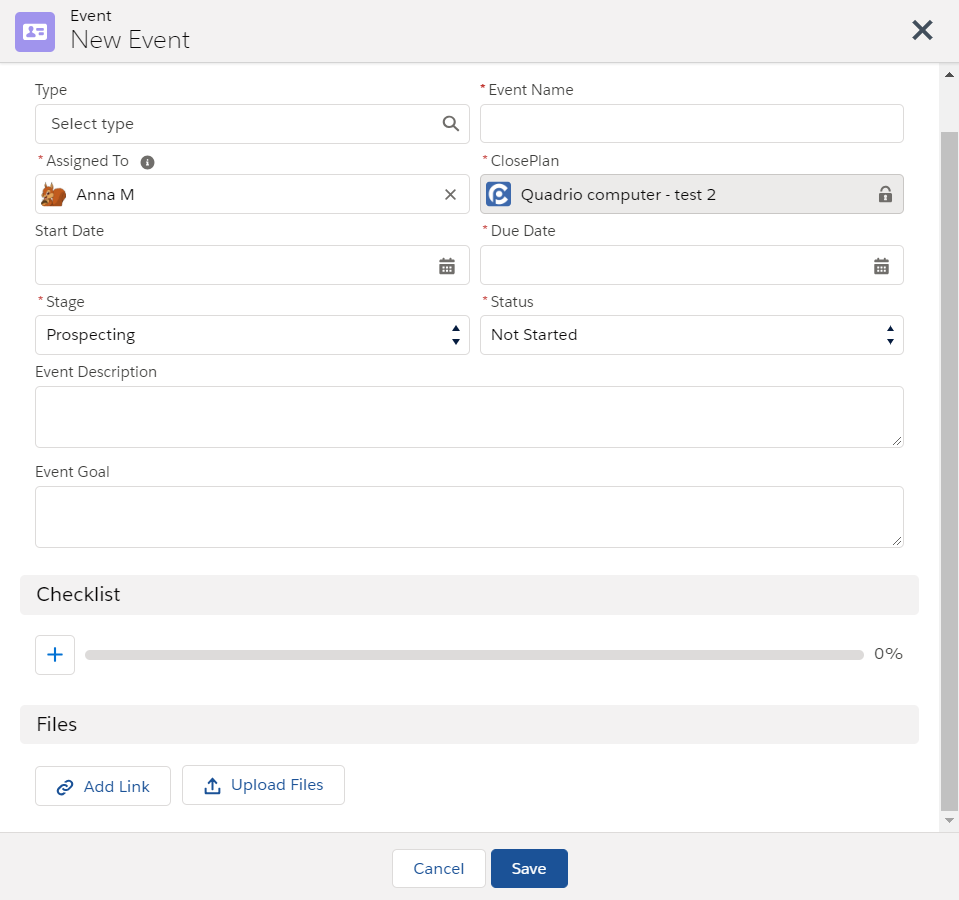
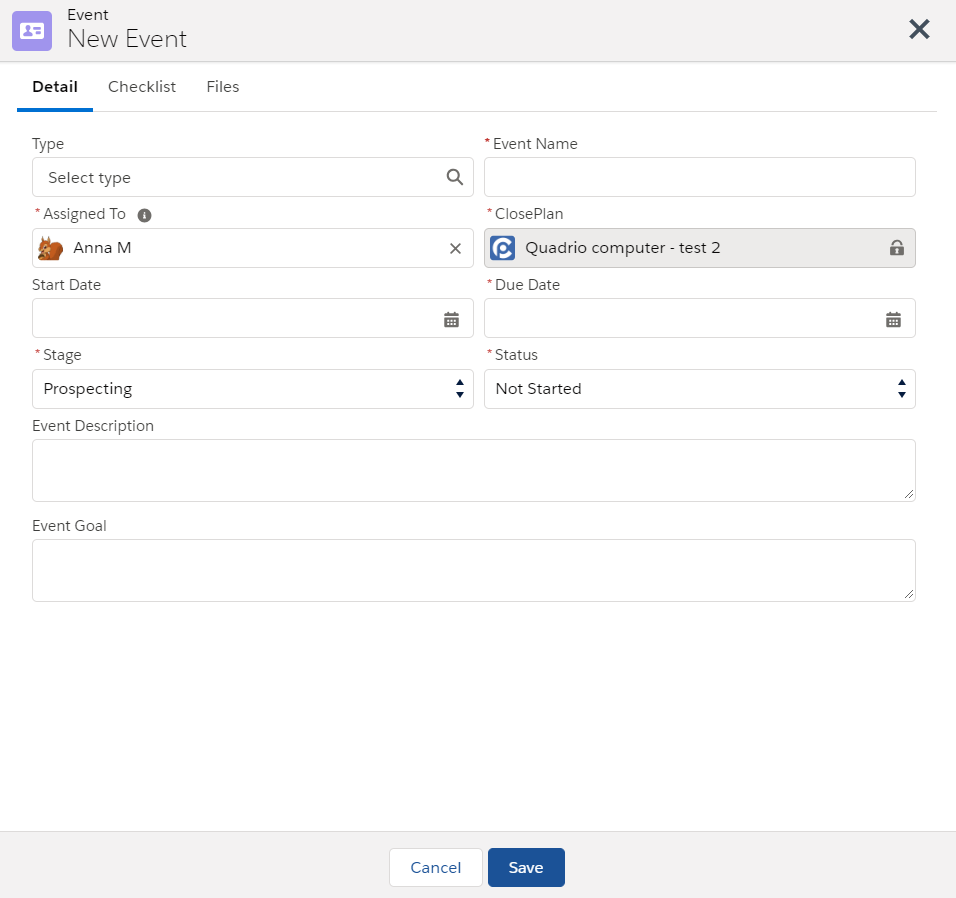
Detail:
Checklist:
The Checklist is used to add tasks for team members. It shows % complete in the progress bar and in the Gantt event bar.

Files:
Allows you to add specific links and/or files to an individual event.

 to add one or more Files
to add one or more Files 
Notes:
Notes enables you to add notes to the event.
Chatter:
Chatter enables you to create a post related to the event that allows for feedback.
If there is not Chatter tab, the Chatter is set as disable.
Event List shows a list of events created by your organization and also newly created events.
With stage progression turned on, Event List displays events for the Current Stage. You can also switch to All Stage view mode.
Current stage display: All stages display:
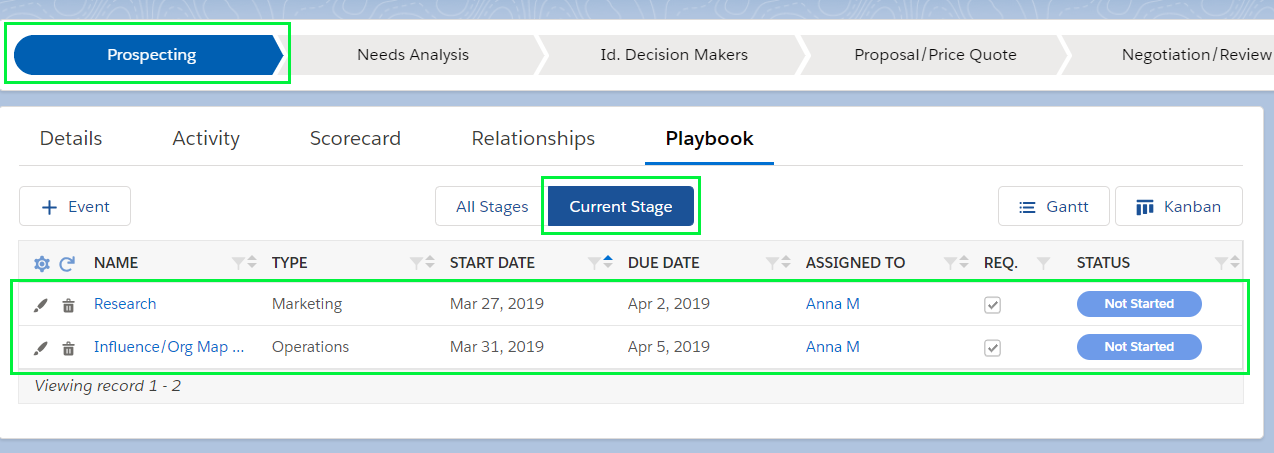
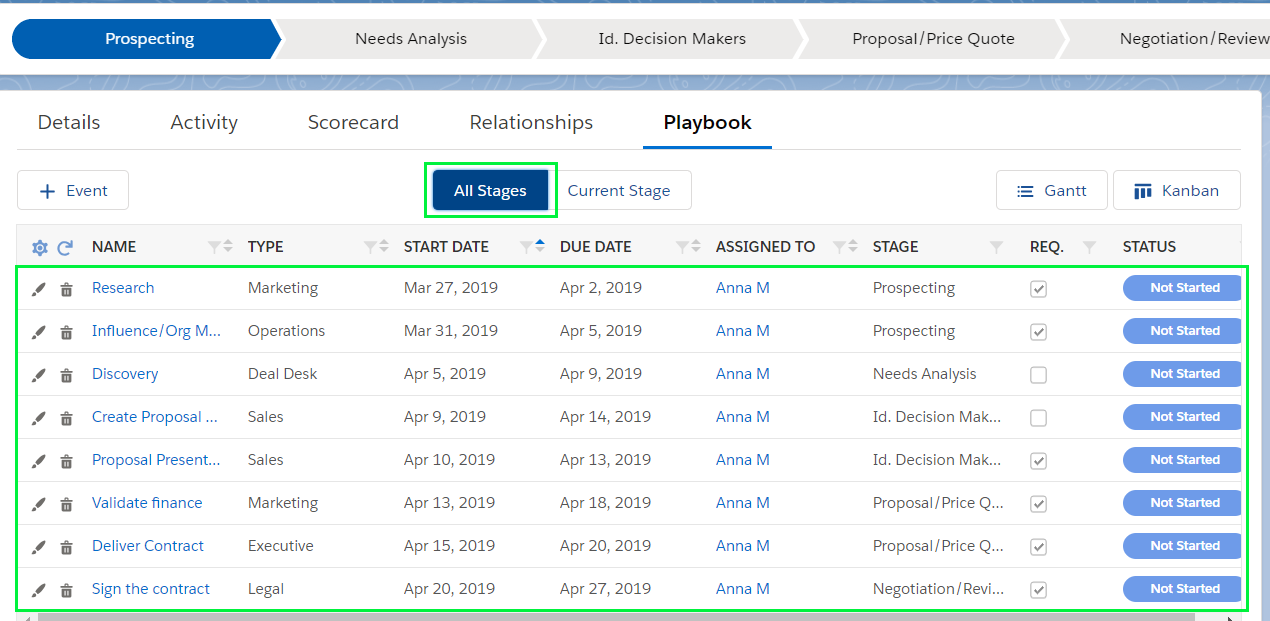

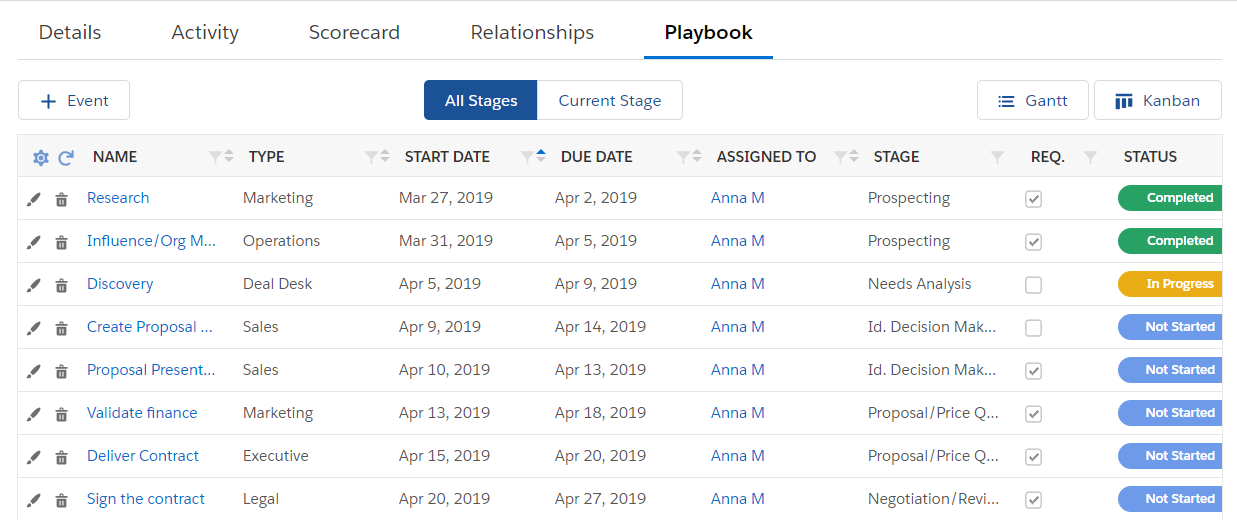
 - Click to create a new event
- Click to create a new event - Shows all events from all stages
- Shows all events from all stages - Shows events only for the current stage
- Shows events only for the current stage - Enables you to Apply Filters and Refresh Data, Apply Filters and Clear Filters
- Enables you to Apply Filters and Refresh Data, Apply Filters and Clear Filters - Delete the Event
- Delete the Event  - The Event has been not started yet - Nobody is working on it
- The Event has been not started yet - Nobody is working on it - The Event is in progress
- The Event is in progress - The Event has been completed
- The Event has been completed - The Event has been terminated. Displays when the Event is terminated and nobody was working on it.
- The Event has been terminated. Displays when the Event is terminated and nobody was working on it. The Gantt chart illustrates the Events in a Grid and Bar area.
If auto stage progression is set, events are sorted by the stage to which they are assigned. (These settings are made when creating a template for a given ClosePlan)
New events can be added directly to the stage.
Gantt displays event dependencies.
If the event has set checklists, the event shows the percentage of their fulfillment.  Toolbar
Toolbar
 - Switches Events view between days, months, year or fit events to the visible Gantt area.
- Switches Events view between days, months, year or fit events to the visible Gantt area. - Scroll the Gantt area left and right or to today's date.
- Scroll the Gantt area left and right or to today's date. - Returns back to the Event List or Kanban
- Returns back to the Event List or Kanban Sidebar area
Sidebar area
The Sidebar area allows you to:
 by the stage to hide events belong to the stage.
by the stage to hide events belong to the stage. Gantt area
Gantt area
Contains Events in the timeline and in stages. Also allows you to see selected time periods (e.g. Q1, Q2).
![]()
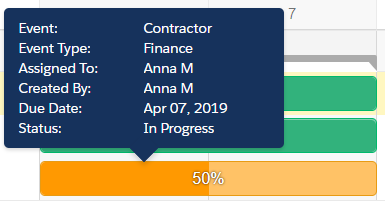

Divides the Events according to current Status.
Drag and drop individual Events to different Status settings.
Click on the desired Event to open the event details. You can add Notes and Chatter posts for the Event, edit or delete the Event, and change the Status.
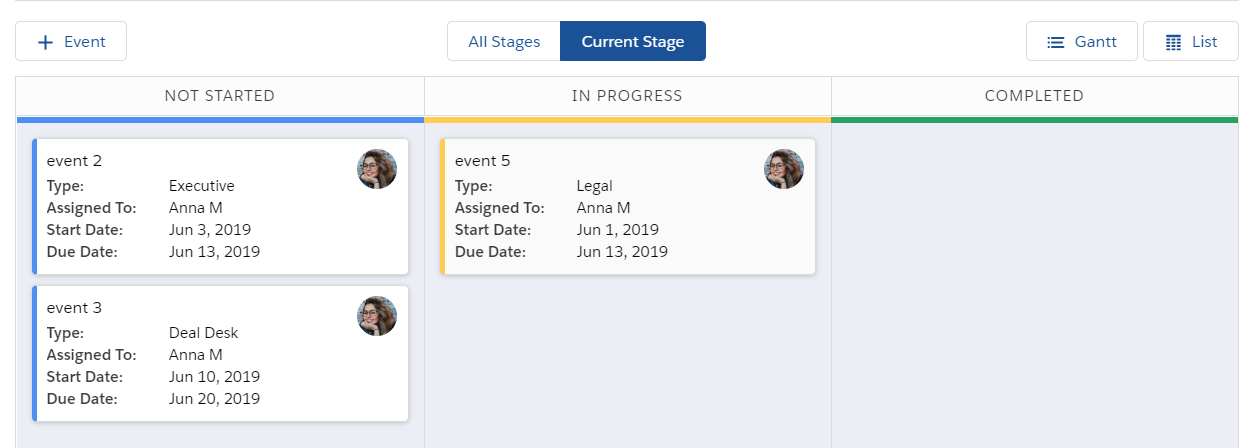
 - Click to create a new Event
- Click to create a new Event - Displays all events across entire ClosePlan
- Displays all events across entire ClosePlan - Displays Events assigned to the current stage
- Displays Events assigned to the current stage - Switch to Gantt chart
- Switch to Gantt chart - Switch to Event List
- Switch to Event List - Click on an individual Event node to open the Event information.
- Click on an individual Event node to open the Event information.